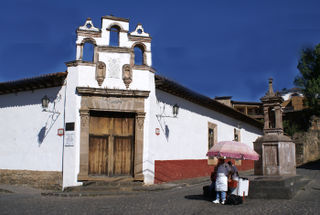
El Museo Regional de Arte Popular (Regional Folk Art Museum), located at the corner of Calle Enseñanza and Calle Alcantarilla in Pátzcuaro, Michoacán. This small museum, the original site of the oldest college in the state of Michoacán, now holds arts and crafts treasures of the regional indigenous Purhépecha people. Exquisite examples of copper, silver, clay, wood, straw, and textile work from the 16th Century to the present allow visitors to compare old and new techniques.
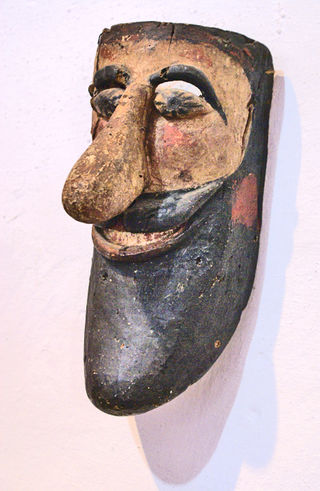
Mexico Cooks! has visited Pátzcuaro's Museo Regional de Arte Popular (Regional Folk Art Museum) so frequently over the course of the last 30 years that we all but have the exhibits memorized. Some of the items are such favorites that at times, they populate our dreams. This marvelously carved wooden dance mask, with its long beard and exceptionally large nose, makes us laugh every time we see it. Notice the cut-out slits between the mask's eyes and the eyebrows. They allowed the wearer to see where he was going while he danced.
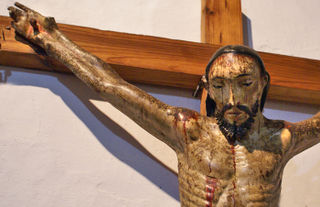
This 17th Century Christ is made of pasta de caña de maíz.
Sometimes erroneously called 'corn dough', the core of the entire Christ figure pictured above is made of a finely kneaded paste created from the ground-up inner parts of cornstalks and a liquid exuded from deltatzingeni (the bulbs of regional orchids). Early artisans created an armature, a 'skeleton' of dried corn leaves and incidental small pieces of wood. Tiny parts (such as fingers) of some figures were sometimes formed using turkey feathers as the armature. Artists then sculpted a figure with pasta de caña. The artisans incorporated insecticides into the corn/orchid paste, which has protected these sculptures over the course of several centuries. The Museo Regional in Pátzcuaro has a number of pasta de caña figures dating to the 16th and 17th Centuries.
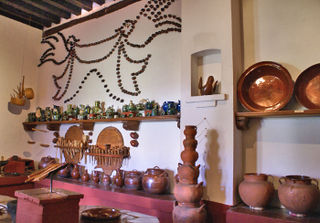
Mexico Cooks! is particularly fond of the museum's display of an early Michoacán kitchen.
In the photo above, you can see many components of a traditional Michoacán cocina (kitchen). The wood-burning cookstove, at lower left, is made of clay-covered adobe. Long rectangular holes for firewood are under recessed round openings for balancing round-bottomed clay cooking pots. Ocote (sticks of fat pine kindling, stored in a metal holder built into the stove, near-middle left) quickly lights the fire. Ollas de barro (clay pots) stack for storing kitchen staples–no lids required. To the right of the stacked ollas, copper vessels line a wooden shelf. Other ollas are ranged around the lower kitchen shelf. At middle left, above the ollas, two carved wood cuchareros (spoon holders) are both decorative and utilitarian. Above the cuchareros, another wooden shelf holds pottery cups and small dishes and pitchers. Above that shelf, the intricate wall art, made of individual tiny clay cups, is typical of nearly every region of Mexico. Whether a simple or complex design, in Mexico's traditional kitchens, it's always made of cups.

A carved wood cupboard, built into the museum wall, holds copper mugs, pitchers, bowls and platters made in Sta. Clara del Cobre, Michoacán. The graduated-size copper utensils hung on either side of the cupboard are measures for dry and liquid ingredients.
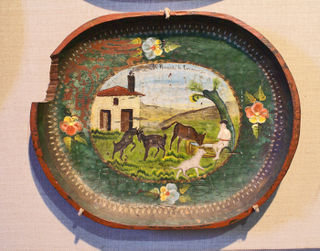
A charola de maque (inlaid lacquer tray) from the 19th Century.
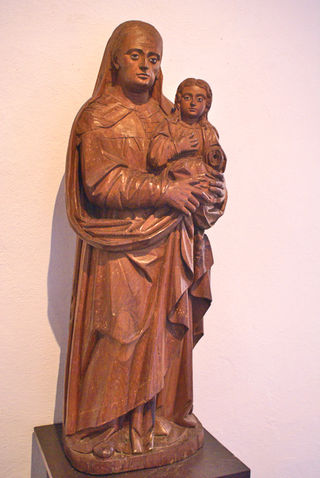
This large carved figure of Saint Ann holding the child Virgin Maria is made of one piece of wood–except for one detail. When you visit the museum on your Mexico Cooks! tour of Pátzcuaro, look closely for the fine line near the ears of both heads. The faces were carved separately to allow for the placement of the figures' glass eyes.

Mexico Cooks! covets this hand-embroidered tablecloth. Every part of the cloth is sewn with a Mexican dicho de la cocina (kitchen sayings). We've often told the museum docents
that if the tablecloth disappears, it will be at our house. For more dichos de la cocina, see Panza Llena, Corazón Contento.
Looking for a tailored-to-your-interests specialized tour in Mexico? Click here: Tours.
Leave a Reply